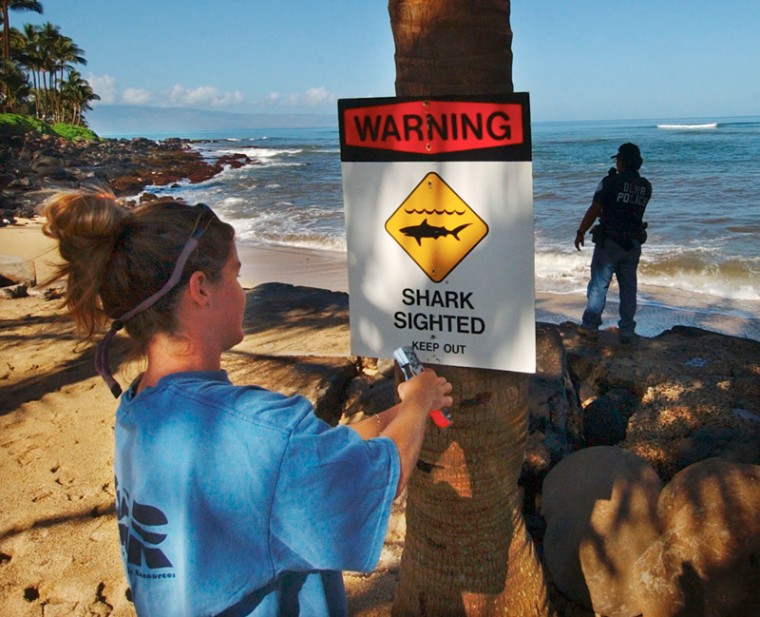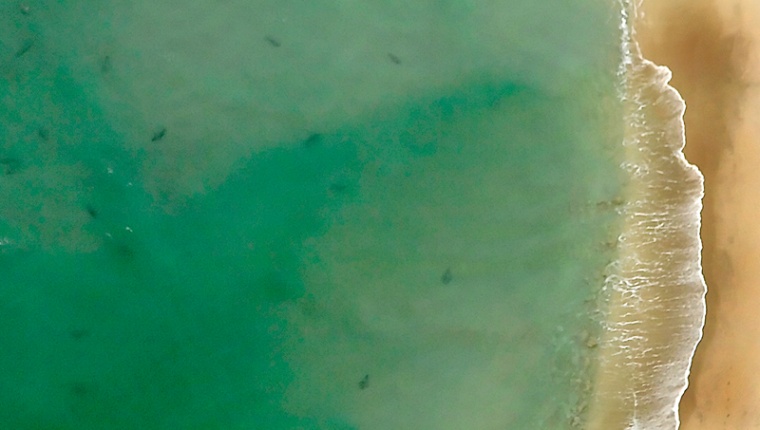Somewhere in the mental file we all have of "ways I don't want to die," deep in the realm of bad dreams, there's an image of a great white shark — black-eyed and toothy, tough-skinned and chomping. Maybe you first saw this 20-foot-long eating machine on Animal Planet. Or maybe it was in “Jaws.” Wherever it came from, the image is there.
Ichthyologists, of course, will say you're being paranoid. You can swim and surf and boogie board with nary a worry at almost any beach on the planet. You are not a seal. Sharks do not want to eat you.
Or do they?
New Smyrna Beach in Volusia County, Fla., is the shark attack capital of the world, according to a database called the International Shark Attack File. Each year, thousands of people dip their toes and then jump in, stroking past the surf and into a zone that's literally thick with sharks.
“Most people who have swum in and around New Smyrna have been within 10 feet of a shark in their lifetime,” says George Burgess, an ichthyologist and fisheries biologist at the University of Florida who maintains the International Shark Attack File (ISAF).
North America is home to dozens of beaches like New Smyrna where swimmers and sharks intermix, even though the humans may never know it. When the rare attack happens, Burgess says, it's usually a predatory mistake. “In the surf zone, where many attacks happen, sharks need to make quick decisions,” he says. “Humans on surfboards — hands splashing, feet kicking — can trigger a shark to think there's trouble or a wounded animal, and it looks like an easy meal.”
With its thousands of miles of coastlines and millions of beachgoers, the United States sees more shark-human interaction than any other country. Search the ISAF database and you'll find incidents at beaches from South Carolina to Oregon. There are so many reports, in fact, that California, Florida, Hawaii, North Carolina and Texas each have dedicated sections in the “Stats, Trends, Analysis” area. In Northern California, seal populations draw great white sharks like flies to fertilizer. When surfers suit up at places like Bolinas Beach and Stinson Beach, they're catching waves in one of the world's most dangerous predator's habitat. Patric Douglas, owner ofShark Diver, an ocean guiding outfit in San Francisco, calls Stinson “the granddaddy of all shark beaches.” He says, “It's common to see 18-footers buzz by surfers bobbing in the waves.”
On the North Shore of Oahu, Hawaii, tiger and hammerhead sharks mix with dolphins and humpback whales. There are dozens of popular surf beaches here, including Velzyland Beach and the Leftovers Break to name just two. Though untold thousands surf and swim here each year without incident, attacks do occur. And at Kahana in West Maui, (not North American, but American) tiger sharks are known to roam. But according to Laleh Mohajerani, executive director of the shark conservation organization Iemanya Oceanica, sharks are not looking to interfere with humans in the water. Our shark-attack fears are irrational.
“You are more likely to be hit by lightning,” she says.
Indeed, there's no arguing the numbers. Of the hundreds of millions of people who enter the ocean each year, almost none are touched.
For 2007, the ISAF cites 50 attacks at U.S. beaches, most of which resulted in minor bite marks and puncture wounds that needed nothing more than a few sutures. “Many attacks are hit and runs — a quick bite and away,” says Burgess. “Few sharks re-attack, as they release the foot or calf after realizing it's not their normal food.”

Even in the Bahamas, where the warm water attracts large tiger sharks, the ISAF records fewer than 10 attacks over the last several decades. Unfortunately for the shark advocates, one fatal attack occurred in February, 2008, prompting a new round of fears.
But for most people, fiery emotions override even the coldest numbers. A single scary story — be it on the news or in an effects-heavy Hollywood production — will destroy the efforts of hundreds of scientists trying to communicate on research and logic.
“The common public perception today of a shark is that of a man-eater,” says Burgess. “We have an innate fear for big predators and natural forces we can't control.”
